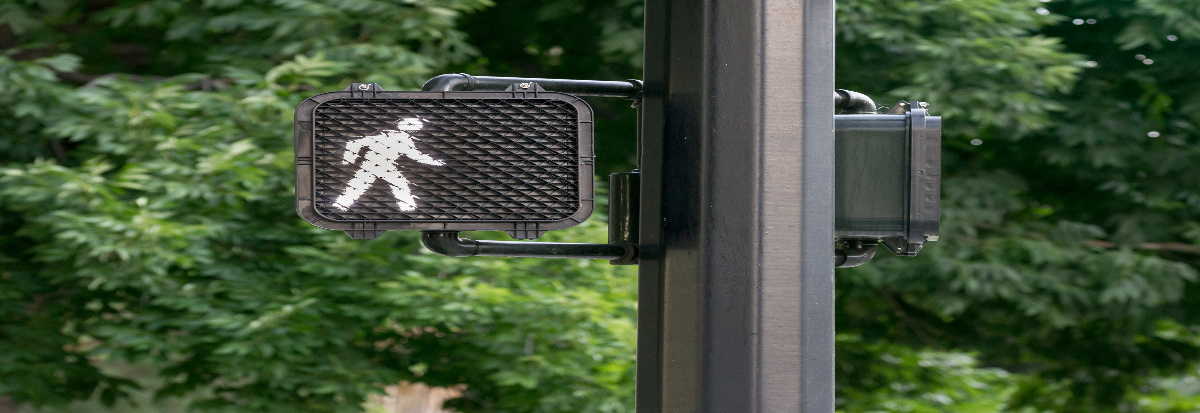
Jump to:
- Crosswalk Right-of-Way and Other Pedestrian Laws
- Showing the “Highest Degree of Care” as a Driver
- How a Pedestrian Accident Attorney Can Help
Walking is a great way to go from place to place. In most cases, it’s good for the body and the environment, as it is a means of exercise and doesn’t require anything more than your own two legs.
Unfortunately, walking has become more dangerous throughout the last decade as pedestrian fatalities have increased considerably. In a study, the Governors Highway Safety Association (GHSA) found a 55% increase in pedestrian deaths in the United States between 2009 and 2018.
There isn’t a single factor that leads to this growing problem, but several causes have pushed our country to this point. A few components of this increase are:
- Distracted driving
- Drivers and pedestrians disobeying traffic laws
- Increased speed limits in areas with high foot traffic/intersections that don’t encourage caution
- Drivers and pedestrians under the influence of drugs or alcohol
- Lack of clear or safe walking paths for pedestrians
Crosswalk Pedestrian Right-of-Way and Other Laws
When it comes to a pedestrian accident, the pedestrian is the vulnerable party and is more exposed to serious injury than the driver or passengers of a vehicle. However, a few rules can help keep you safer when using a crosswalk or roadways.
3 Rules for the Crosswalk in Missouri
Crosswalks are one of the biggest points of contention when addressing pedestrian accidents, as they are the designated safe paths for individuals to cross the road. Here are three things you need to know about crosswalks in Missouri:
- When there is a “Walk” and “Don’t Walk” signal at a crosswalk, you need to follow that instruction. If you’re in the middle of an intersection when the signal changes, you’re permitted to keep crossing to the sidewalk or designated “safe zone.”
- If the crosswalk doesn’t have an electronic signal attached to the traffic light, oncoming traffic should yield to you as the pedestrian.
- When approaching a crosswalk, it’s essential to only cross at right angles and avoid walking diagonally across the intersection unless it’s marked to do so. While it may take slightly longer to get to your destination, this rule eliminates the distance you have to cross at one time and the amount of time you’re in the intersection. It’s also best to use designated crosswalks in an urban area.
Walk With or Against Traffic Law – Staying Safe as a Pedestrian
Even though it may take more time, crossing the roadway between adjacent intersections can cause a driver not to have enough time to hit the brakes. It’s best to use available walking paths as a safe zone to avoid a collision. Don’t step off of a curb or safe zone as a car approaches.
When a walkway or sidewalk isn’t available, you should stick to the shoulder of the lane facing traffic. Walking in this direction allows you to see oncoming traffic, negate swerves and avoid wandering into the road.
Hitting a Pedestrian in a Crosswalk: Driver Laws and the “Highest Degree of Care”
If you’re at the wheel, you’re responsible for showing the highest degree of care to prevent a potential pedestrian accident. The best way to protect pedestrian lives is to drive defensively and never drive under the influence of drugs and alcohol. It’s your duty of care to follow traffic laws and to be ready for a potential pedestrian crossing.
Common Pedestrian Accident Injuries
Pedestrian accidents can be extremely serious. If you are involved in a pedestrian accident, there are a number of injuries you may sustain, including:
- Broken bones
- Back or spinal injuries
- Brain damage
- Internal organ damage
- Soft tissue damage
How a Pedestrian Accident Lawyer Can Help
If you’ve been injured by a negligent driver, you’ve probably had to endure extreme physical, emotional, psychological and financial pain. You deserve justice, and you shouldn’t have to carry these financial burdens alone. Drivers must be held responsible for their actions.
Negligent drivers and insurance companies almost always try to pin at least a portion of the blame on the injured pedestrian, which adds unnecessary stress to you after your injury. Our Columbia personal injury attorneys work to prove the liability of the driver by analyzing the details of the accident. We consider factors such as:
- Whether you were in a crosswalk at the time of your accident
- Whether there was a “walk” symbol when you crossed the street
- Whether there was appropriate signage in the area to control traffic
- Whether the driver was under the influence of drugs or alcohol
- Whether the driver was speeding or driving recklessly at the time of the accident
The experienced law team at Eng and Woods can help you get the compensation you need to fully recover from your injuries and cover expenses while you’re unable to work. We’re a team that’s dedicated to protecting those who can’t protect themselves from negligent parties and predatory insurance companies.
Let us aggressively advocate for you in the courtroom to secure the financial aid that you need to pay your medical and rehabilitation costs and compensate you for all the pain and suffering that you have had to endure since your accident.
Visit our contact page or start a chat to tell us about your accident. From there, we can set up a consultation to walk through your pedestrian accident case and how to get maximum compensation for your injury.
By
Eng & Woods
|
Published
June 23, 2022
|
Posted in